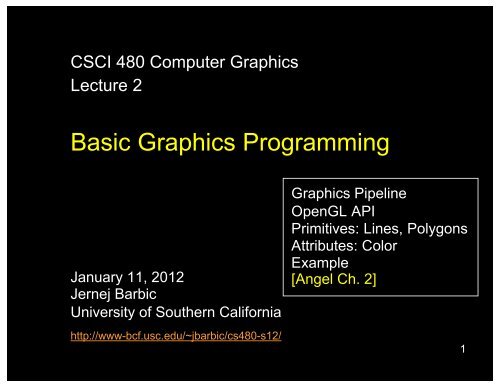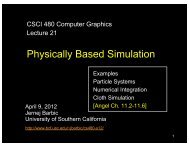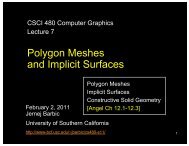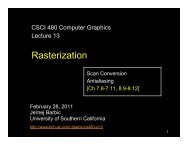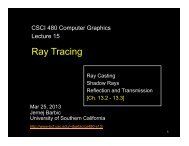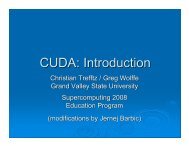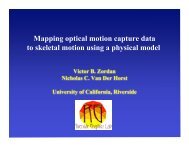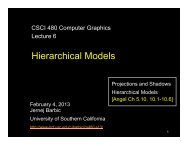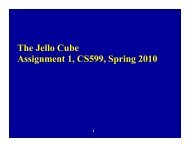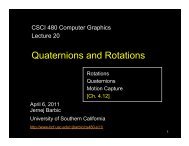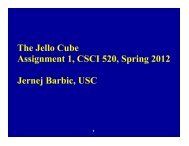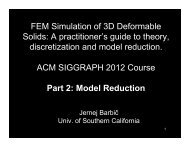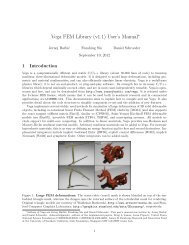Basic Graphics Programming - University of Southern California
Basic Graphics Programming - University of Southern California
Basic Graphics Programming - University of Southern California
You also want an ePaper? Increase the reach of your titles
YUMPU automatically turns print PDFs into web optimized ePapers that Google loves.
CSCI 480 Computer <strong>Graphics</strong><br />
Lecture 2<br />
<strong>Basic</strong> <strong>Graphics</strong> <strong>Programming</strong><br />
January 11, 2012<br />
Jernej Barbic<br />
<strong>University</strong> <strong>of</strong> <strong>Southern</strong> <strong>California</strong><br />
http://www-bcf.usc.edu/~jbarbic/cs480-s12/<br />
<strong>Graphics</strong> Pipeline<br />
OpenGL API<br />
Primitives: Lines, Polygons<br />
Attributes: Color<br />
Example<br />
[Angel Ch. 2]<br />
1
What is OpenGL<br />
• A low-‐level graphics library (API) for 2D and 3D<br />
interac>ve graphics.<br />
• Descendent <strong>of</strong> GL (from SGI)<br />
• First version in 1992; now: 4.2 (2012)<br />
• Managed by Khronos Group (non-‐pr<strong>of</strong>it consor>um)<br />
• API is governed by Architecture Review Board<br />
(part <strong>of</strong> Khronos)<br />
2
Where is OpenGL used<br />
• CAD<br />
• Virtual reality<br />
• Scien>fic visualiza>on<br />
• Flight simula>on<br />
• Video games<br />
3
<strong>Graphics</strong> library (API)<br />
• Intermediary between applica>ons and<br />
graphics hardware<br />
• Other popular APIs:<br />
Direct3D (MicrosoU)<br />
OpenGL ES (embedded devices)<br />
X3D (successor <strong>of</strong> VRML)<br />
4
OpenGL is cross-platform<br />
• Same code works with liYle/no modifica>ons<br />
• Implementa>ons:<br />
Windows, Mac, Linux: ships with the OS<br />
Linux: Mesa, a freeware implementa>on.<br />
5
How does OpenGL work<br />
From the programmer’s point <strong>of</strong> view:<br />
1. Specify geometric objects<br />
2. Describe object properties<br />
• Color<br />
• How objects reflect light<br />
6
How does OpenGL work (continued)<br />
3. Define how objects should be viewed<br />
• where is the camera<br />
• what type <strong>of</strong> camera<br />
4. Specify light sources<br />
• where, what kind<br />
5. Move camera or objects<br />
around for animation<br />
7
The result<br />
the result<br />
8
OpenGL is a state machine<br />
State variables: color, camera position,<br />
light position, material properties...<br />
These variables (the state) then apply to<br />
every subsequent drawing command.<br />
They persist until set to new values<br />
by the programmer.<br />
9
OpenGL Library Organization<br />
• GL (<strong>Graphics</strong> Library): core graphics capabilities<br />
• GLU (OpenGL Utility Library): utilities on top <strong>of</strong> GL<br />
• GLUT (OpenGL Utility Toolkit): input and windowing<br />
10
<strong>Graphics</strong> Pipeline<br />
Primitives+<br />
material<br />
properties<br />
Translate<br />
Rotate<br />
Scale<br />
Is it visible<br />
on screen?<br />
3D to 2D Convert to<br />
pixels<br />
Shown<br />
on the screen<br />
(framebuffer)<br />
11
OpenGL uses immediate-mode rendering<br />
• Application generates stream <strong>of</strong><br />
geometric primitives (polygons, lines)<br />
• System draws each one into the framebuffer<br />
• Entire scene redrawn anew every frame<br />
• Compare to: <strong>of</strong>f-line rendering<br />
(e.g., Pixar Renderman, ray tracers)<br />
12
The pipeline is implemented by<br />
OpenGL, graphics driver and<br />
the graphics hardware<br />
OpenGL programmer does not need to implement<br />
the pipeline.<br />
However, pipeline is reconfigurable if needed<br />
“shaders”<br />
13
<strong>Graphics</strong> Pipeline<br />
• Efficiently implementable in hardware<br />
(but not in s<strong>of</strong>tware)<br />
• Each stage can employ multiple specialized processors,<br />
working in parallel, busses between stages<br />
• #processors per stage, bus bandwidths are fully<br />
tuned for typical graphics use<br />
• Latency vs throughput<br />
14
Vertices<br />
• Vertices in world coordinates<br />
• void glVertex3f(GLfloat x, GLfloat y, GLfloat z)<br />
– Vertex (x, y, z) is sent down the pipeline.<br />
– Function call then returns.<br />
• Use GLtype for portability and consistency<br />
• glVertex{234}{sfid}[v](TYPE coords)<br />
15
Transformer<br />
• Transformer in world coordinates<br />
• Must be set before object is drawn!<br />
glRotatef(45.0, 0.0, 0.0, -1.0);<br />
glVertex2f(1.0, 0.0);<br />
• Complex [Angel Ch. 4]<br />
16
Clipper<br />
• Mostly automatic (must set viewport)<br />
17
Projector<br />
• Complex transformation [Angel Ch. 5]<br />
Orthographic Perspective<br />
18
Rasterizer<br />
• Interesting algorithms [Angel Ch. 7]<br />
• To window coordinates<br />
• Antialiasing<br />
19
Primitives<br />
• Specified via vertices<br />
• General schema<br />
glBegin(type);<br />
glVertex3f(x1, y1, z1);<br />
...<br />
glVertex3f(xN, yN, zN);<br />
glEnd();<br />
• type determines interpretation <strong>of</strong> vertices<br />
• Can use glVertex2f(x,y) in 2D<br />
20
Example: Draw Square Outline<br />
• Type = GL_LINE_LOOP<br />
glBegin(GL_LINE_LOOP);<br />
glVertex3f(0.0, 0.0, 0.0);<br />
glVertex3f(1.0, 0.0, 0.0);<br />
glVertex3f(1.0, 1.0, 0.0);<br />
glVertex3f(0.0, 1.0, 0.0);<br />
glEnd();<br />
• Calls to other functions are allowed between<br />
glBegin(type) and glEnd();<br />
21
Points and Line Segments<br />
glBegin (GL_POINTS);<br />
glVertex3f(…);<br />
…<br />
glVertex3f(…);<br />
glEnd();<br />
Draw points<br />
22
Polygons<br />
• Polygons enclose an area<br />
• Rendering <strong>of</strong> area (fill) depends on attributes<br />
• All vertices must be in one plane in 3D<br />
23
Polygon Restrictions<br />
• OpenGL Polygons must be simple<br />
• OpenGL Polygons must be convex<br />
(a) simple, but not convex<br />
(b) non-simple<br />
(c) convex<br />
24
Why Polygon Restrictions?<br />
• Non-convex and non-simple polygons are<br />
expensive to process and render<br />
• Convexity and simplicity is expensive to test<br />
• Behavior <strong>of</strong> OpenGL implementation on<br />
disallowed polygons is “undefined”<br />
• Some tools in GLU for decomposing complex<br />
polygons (tessellation)<br />
• Triangles are most efficient<br />
25
Polygon Strips<br />
• Efficiency in space and time<br />
• Reduces visual artefacts<br />
• Polygons have a front and a back, possibly with<br />
different attributes!<br />
26
Attributes:<br />
color, shading and reflection properties<br />
• Part <strong>of</strong> the OpenGL state<br />
• Set before primitives are drawn<br />
• Remain in effect until changed!<br />
27
Physics <strong>of</strong> Color<br />
• Electromagnetic radiation<br />
• Can see only tiny piece <strong>of</strong> the spectrum<br />
28
Color Filters<br />
• Eye can perceive only 3 basic colors<br />
• Computer screens designed accordingly<br />
Amplitude<br />
G<br />
B<br />
R<br />
Wavelength [nanometer]<br />
Source: Vos & Walraven<br />
29
Color Spaces<br />
• RGB (Red, Green, Blue)<br />
– Convenient for display<br />
– Can be unintuitive (3 floats in OpenGL)<br />
• HSV (Hue, Saturation, Value)<br />
– Hue: what color<br />
– Saturation: how far away from gray<br />
– Value: how bright<br />
• Other formats for movies and printing<br />
30
RGB vs HSV<br />
Gimp Color Picker<br />
R<br />
B<br />
G<br />
G<br />
B<br />
R<br />
G<br />
B<br />
V<br />
H<br />
R<br />
S<br />
31
Example: Drawing a shaded polygon<br />
• Initialization: the “main” function<br />
int main(int argc, char** argv)<br />
{<br />
glutInit(&argc, argv);<br />
glutInitDisplayMode (GLUT_DOUBLE | GLUT_RGB);<br />
glutInitWindowSize (500, 500);<br />
glutInitWindowPosition (100, 100);<br />
glutCreateWindow (argv[0]);<br />
init ();<br />
...<br />
32
GLUT Callbacks<br />
• Window system independent interaction<br />
• glutMainLoop processes events<br />
...<br />
glutDisplayFunc(display);<br />
glutReshapeFunc(reshape);<br />
glutKeyboardFunc (keyboard);<br />
glutMainLoop();<br />
return 0;<br />
}<br />
33
Initializing Attributes<br />
• Separate in “init” function<br />
void init(void)<br />
{<br />
glClearColor (0.0, 0.0, 0.0, 0.0);<br />
}<br />
/* glShadeModel (GL_FLAT); */<br />
glShadeModel (GL_SMOOTH);<br />
34
The Display Callback<br />
• The routine where you render the object<br />
• Install with glutDisplayFunc(display)<br />
void display(void)<br />
{<br />
glClear (GL_COLOR_BUFFER_BIT); /* clear buffer */<br />
setupCamera(); /* set up the camera */<br />
triangle (); /* draw triangle */<br />
glutSwapBuffers (); /* force display */<br />
}<br />
35
Drawing<br />
• In world coordinates; remember state!<br />
void triangle(void)<br />
{<br />
glBegin (GL_TRIANGLES);<br />
glColor3f (1.0, 0.0, 0.0); /* red */<br />
glVertex2f (5.0, 5.0);<br />
glColor3f (0.0, 1.0, 0.0); /* green */<br />
glVertex2f (25.0, 5.0);<br />
glColor3f (0.0, 0.0, 1.0); /* blue */<br />
glVertex2f (5.0, 25.0);<br />
glEnd();<br />
}<br />
36
The Image<br />
glShadeModel(GL_FLAT) glShadeModel(GL_SMOOTH)<br />
color <strong>of</strong> last vertex each vertex separate color<br />
smoothly interpolated<br />
37
Flat vs Smooth Shading<br />
Flat Shading Smooth Shading<br />
38
Projection<br />
• Mapping world to screen coordinates<br />
void reshape(int w, int h)<br />
{<br />
glViewport (0, 0, (GLsizei) w, (GLsizei) h);<br />
glMatrixMode (GL_PROJECTION);<br />
glLoadIdentity ();<br />
if (w
Orthographic Projection<br />
• 2D and 3D versions<br />
• glOrtho2D(left, right, bottom, top)<br />
• In world coordinates!<br />
40
Viewport<br />
• Determines clipping in window coordinates<br />
• glViewPort(x, y, w, h)<br />
41
Summary<br />
1.<br />
2.<br />
3.<br />
4.<br />
5.<br />
A <strong>Graphics</strong> Pipeline<br />
The OpenGL API<br />
Primitives: vertices, lines, polygons<br />
Attributes: color<br />
Example: drawing a shaded triangle<br />
42


